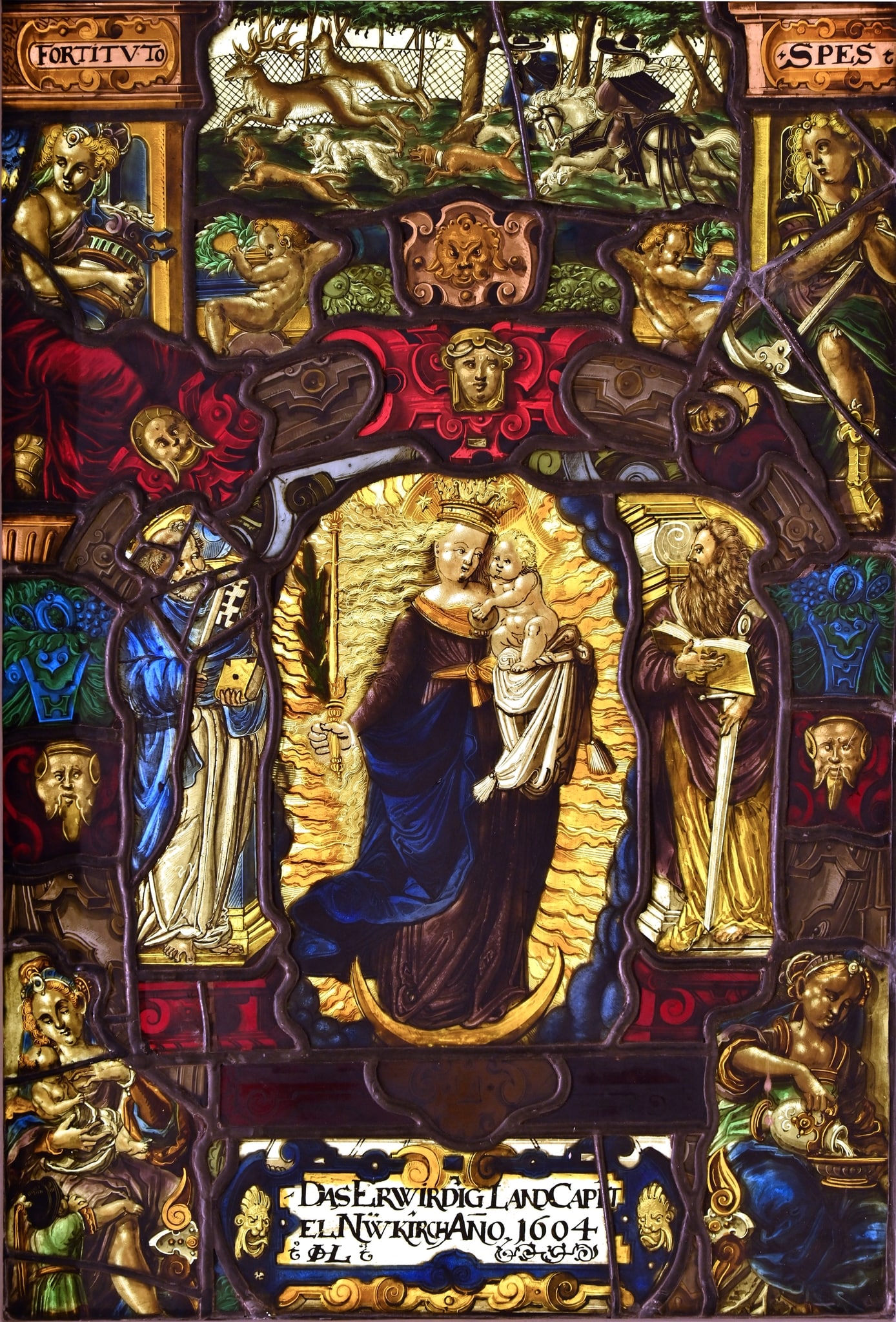Neunkirch is a town about 8 kilometers (5 miles) from Schaffhausen and 32 kilometers (20 miles) west of Constance. The town is on the southern border of Germany. The Bergkirche is now part of the Swiss Reformed Church, but before the Reformation the church was administered by the diocese of Constance and honored the Virgin Mary as patron.
The image of the Virgin clothed with the sun and the moon under her feet has its roots in Christian prophecy: “And a great sign appeared in heaven: A woman clothed with the sun, and the moon under her feet, and on her head a crown of twelve stars” (Revelation 12:1). The passage describes a woman giving birth to a son and being pursued by a dragon with seven heads crowned with seven diadems. Medieval tradition elides the woman in Revelation with the Virgin Mary, and in Germany the image is called the Strahlenkranzmadonna. The earliest image has been ascribed to the manuscript Hortus Deliciarum, dated 1167–1185 (Hortus Deliciarum, Strasbourg, 1899, frontispiece, PL LXXVI). The image was later associated with the theological concept of the Immaculate Conception (Catholic dogma since 1854) that the Virgin alone among the human race was conceived without original sin. The belief had been upheld by various groups since the eighth century. In 1477 Sixtus IV introduced the feast in the Diocese of Rome, thus establishing papal support (Reynolds, 2012).
Albrecht Dürer’s engraving of the Virgin on the Crescent with Scepter and Starry Crown (1516; Metropolitan Museum of Art, 19.73.39) shows the image of Mary, Queen of Heaven fused with Mary the loving mother holding her chubby baby. The image was often represented in Swiss Renaissance windows. Twelve of the windows dating from 1520 through 1626 in Cloister Wettingen show variations (Hoegger, 2002, pp. 82, 89, 94, 99, 113, 133, 136, 139, 156, 178, 190, 198, 263, 271–72, 278, 284–85, 302–304, 326, 329–30, 332–34, 355–56, 377–78, 391–92, 400–401). Wetting is in the vicinity (40 kilometers) from Neunkirch. The same type appears in the glazing of the Cloister of Muri, twice associated arms of with abbots, Joachim Eichorn, abbot of Einsiedeln given in 1557, and Jodok Krämer, abbot of Engelberg, given in 1564. The Standesscheibe of Baden, shows the image on the banners of the city (Hasler, 2002a, pp. 48–49, 80–81, 88–90, 116, 119, 144–45, 182–83, 194–95, 234–35).
The Four Virtues of the corners are typical for glass panels at this time. Strength holds the column (an allusion to the columns brought down by Sampson on the Philistines (Judges 16:25–30). Hope, with an anchor is in the upper right. In the lower left, Charity whose inscription has been lost, nurses one child while another plays at her feet and to the lower right, Temperance, also missing her inscription, pours water into a bowl of wine. The representations of virtues and vices were common throughout the Middle Ages and frequently appeared in cathedral façade programs in association with Last Judgment theme. The later Middle Ages saw several alternations of the symbols, such as the emblems for Strength. As in this panel, a column was frequently substituted for the earlier motifs of a shield and armor. See, for a mid-sixteenth-century Swiss series with these symbols, Jos Murer (1530–1580), drawings in the British Museum and elsewhere on the Virtues (see online collection, British Museum).
Hieronymus Lang the Younger (1570–1611) was a member of a distinguished and prolific family of glass painters of Schaffhausen. Rolf Hasler has provided information on the family and identified the Princeton panel (Hasler, 2010, pp. 101–116, fig. 85) which lasted through four generations. Hans Caspar Lang the Younger, baptized in 1599, died in 1624, was the last glass painter of the dynasty. The founder was Hieronymus Lang the Elder (1520–1582), whose work is identified by a drawing dated 1547, Heraldic Panel with Double Arms of the Abbey of St. Blasien, Schwarzwald, and Abbot Kaspar I Müller that was the basis for a panel now in the Los Angeles County Museum of Art (47.21.21; Raguin, 2024, vol. 1, p. 135; US_21). Hieronymus Lang the Elder’s son Daniel, born in 1543 inherited his father’s house in 1588. He had a younger brother, Martin Lang, baptized in 1546 who also followed the profession, although little is known about his oeuvre. Daniel’s son Hans Caspar Lang the Elder, baptized in 1571, expanded the family’s renown as well as producing a son who continued the profession, cited above. Hieronymus Lang the Younger, who also used the name of Onymus Lang the Younger was the son of Adrian Lang, one of four recorded sons of Hieronymus Lang the Elder. In 1597 he married Judith Egli, the widow of the Winterthur glazer Lienhard Brun II and in the same year established an independent workshop. He was known as an accomplished panel painter as well as a glasspainter. Lang’s elongated faces and solid, muscular forms in the virtues and putti was a long-lived tradition. Christof Kaufmann executed a panel in the reverse glass painting technique in 1633 (Romont, Vitrocentre Museum; PSV_937) where the image of Charity displays similar body type. A panel showing the Virgin on the Crescent dated to about 1560 to 1570 has been ascribed to the workshop of Hieronymus Lang the Elder (Schaffhausen, Museum zu Allerheiligen Mus. Inv. 54989; Hasler, 2010, pp. 201–202, no. 17).
Cited
Record of the Art Museum, 1963, p. 19.
Raguin, & Morgan, 1987, p. 83.
Raguin, 1987, p. 51, no. 15.
